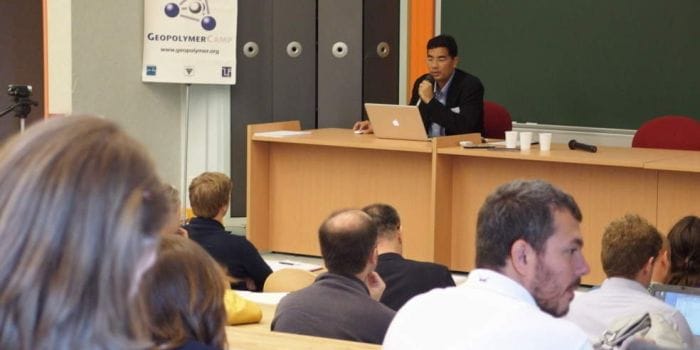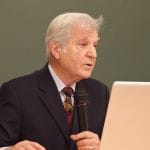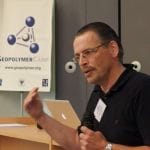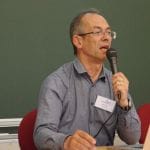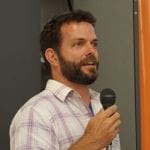The Geopolymer Camp 2014, was held on July 7th to 9th at the IUT, University of Picardie, in Saint-Quentin, France. You will find below three Keynote conferences, the list of short communications and panel-groups and some photos taken during this event.
Special thanks to our sponsor: AVENSO (Avenir Energies Solutions, Dominique Bruch)
PROGRAMME
The GeopolymerCamp 2014 spanned 3 days:
Special topic of interest: World’s first public building with structural Geopolymer Concrete in Brisbane, Australia.
Monday July 07 afternoon
14:00-15:30: Registration
15:30-18:30: Individual introduction; each GP Camp participant introduces himself: affiliation, main interest, project involvement, etc. (3 min. per person). Preparation of the sessions schedule, groups of interests, themes.
Tuesday July 08:
9:00: Prof. Joseph Davidovits Keynote: State of the Geopolymer R&D, 2013.
10:45-13:00: First session Themes: What is a geopolymer?
Keynote by Erik G. Søgaard, Aalborg University, Denmark, “Silica-based geopolymer: oligomers characterization”.
13:00: Free Sandwich Lunch
14:00 – 14:45: Keynote by Zdeněk Krahula, Sandteam, Spol.S R.O, Czech Republik, “GEOPOL®- The technology of mould and core production with inorganic binder system in foundry industry”.
14:45-15:30: Second session: Themes: industrial applications (foamed panels, ceramics, high temperature, binders, composites, toxic and radioactive waste containment)
16:30-17:00: Poster session
17:00-18:30 Third Session Ancient Technologies: Geopolymer and Roman cement, restoration of cultural heritage.
Wednesday July 09:
9:00 – 11:00: 4th Session: Themes: building applications, LTGS, bricks, cements, concretes, Eco-building, etc. Chair: Dr. Parames Kamhangrittirong, Kasetsart University, Bangkok
11:00 – 13:00: Panels – Groups
13:00: Free Sandwich Lunch
+ Panels – Groups
Keynote Conferences in video
State of the Geopolymer R&D 2014
It is a review on what happened in 2013 and the first semester of 2014 on geopolymer science and applications. In his keynote, Prof. J. Davidovits developed following topics:
1) Geopolymer science
- Exponential increase of laboratories and scientific publications
- Future creation of the Journal of Geopolymer Science
- Report on Geopolymer WEBINAR 2013 April 16-17: The basics of geopolymer science
- State of the 15 Research topics on geopolymer science
- Study of ESPCI-ParisTech, microsilica-based (silica fume) Si speciations in Na-silicate solutions
- Alkali-activation vs geopolymerization
- Ferro-sialate (-Fe-O-Si-O-Al-O-) rock-based geopolymer cement
- Silica-based geopolymer resin (Na,K)nano-poly(silanol)
- Phosphate-based geopolymer, AlPO4 isomorphs
- Organic-mineral geopolymer: phenolic, water-based latex, ethyl ester silicate silane, epoxy, compatibility rule: Napoli Parthenope Univ.
- Geopolymer in ceramic processing, high temperature ceramics (Cs, Li, Ga, Ge)
- Geopolymer concrete: First structural geopolymer concrete (Brisbane, Wagners/Hasell)
2) Geopolymer technologies
- More and more jobs creation, which means success in the development of the chemistry.
3) Geopolymer Cements / Concretes
- Nuclear Decommissioning Authority in UK, reported that Lucideon studied the encapsulation of waste that exceed their expectations.
- Miliken launched a new product, GeoSpray, a special mortar and grout for infrastructure rehabilitation.
- North Carolina Charlotte University in the US developed a solar house with fly-ash based geopolymer concrete walls with colling pipes in it.
- University of Queensland, Brisbane, Australia, has built a Global Change Institute which is the world’s first building to successfully use geopolymer concrete for structural purposes.
- Autralian company Wagners released their Earth Friendly Concrete (EFC, Wagners’ trade mark for geopolymer concrete).
- Technical data on Wagners’ geopolymer concrete.
4) Geopolymer and archaeology
- Session developped during this GPCamp.
———————————————————-
Keynote: “GEOPOL® – The technology of mould and core production with inorganic binder system in foundry industry” by Ing. Zdeněk Krahula, Sandteam, Spol.S R.O, Czech Republik.
———————————————————-
Keynote: “Silica-based geopolymer: oligomers characterization” by Prof. Erik G. Søgaard, Aalborg University, Denmark.
ACCESS TO THE PRESENTATIONS
Download and read the presentations given in front of the Geopolymer Camp attendance. Click here to access to the files.
Small communications
Session 1: Geopolymer molecular chemistry, scientific investigations, raw materials.
- Annalisa Natali Murri, CertiMaC./ISTEC CNR, Italy: Chemical consolidation of vegetal and animal derived biomass ashes: a case study
- Lieven Machiels, K. University Leuven, Belgium: Plasmastone: a novel raw materials for geopolymers
- Dominique Bruch, AVENSO (Avenir Energies Solutions), Martinique, France: The need for on-site simple analytical means
- Joseph Davidovits, Geopolymer Institute Saint-Quentin: Discussion on creating the “Journal of Geopolymer Science”
Session 2: industrial applications (foamed panels, ceramics, high temperature, binders, composites, toxic and radioactive waste containment)
- Soumaya Louati, Ecole Nationale d’Ingénieurs de Sfax, Tunisia: Structural, thermal, and dielectric characterizations of “green” phosphoric acid-based geopolymers
- Roni Martins Schmeling, Wincret Designer Concrete Products, Brazil: Decorative and architectural geopolymer panels
- Brian Day, Old Hall Barn, UK: Does geopolymer technology provide materials and methods for producing finished sculpture?
- Jae-Sol Lee, KONES (Korea Nuclear Engineering Services), Korea: Materials for development of containers for radioactive waste management.
Poster session
- Davidovits & al.: The European Research Project GEOASH, Geopolymer Cement Based on European Fly Ashes
- F.A.A. + Rutgers U.: Fire-Safety Solutions with Geopolymer Composites
- Geopolymer Institute: Dehydroxylation Mechanism of Kaolinite into Metakaolin (MK-750)
- Geopolymer Institute: The Mineral Polymer Concept: Silicones and Geopolymers with Covalent Bonding
- Ralph Davidovits & al.: 25,000 Year-old Geopolymer Ceramic ? Low-Temperature Manufacture of Prehistoric Black Ceramic
- Frédéric Davidovits: 2,000 Year-old Roman Cement and Modern Geopolymer Cement: Vitruvius’ Work De Architectura re-visited
Session 3: Ancient Technologies
- Video, Part 10, Geopolymer Webinar Spring 2014, Geopolymer – Roman cement
- Frédéric Davidovits, Geopolymer Institute, France: 2,000 Year-old Roman Cement: geology and ancient texts
- Sergio Tamburini, CNR – IENI, Italy: Challenging Materials for Restoration of Cultural Heritage
Session 4: building applications, LTGS, bricks, cements, concretes, Eco-building, etc.
- Joseph Davidovits, Geopolymer Institute: The 6 basic rules in Geopolymer cement processing (+2 videos)
- Minna Sarkkinen, Kajaani University, Finland: Geomaterials project – Geopolymer binder mix development for structural applications
- Tero Luukkonen, Kajaani University, Finland: Utilization of metakaolin based geopolymer as an effective sorbent medium in various water treatment applications
- Ivan Man Lung Sham, Nano & Advanced Materials Institute, China: Advanced materials developments in Hong Kong
- Mihovil Zmar, University of Zagreb, Croatia: Academic solidarity with geopolymer
- Parames Kamhangrittirong, Kasetsart University, Bangkok, Thailand: The engineering properties and microstructure of high calcium fly ash based geopolymer from Mae-moh power plant
- David Andresen, Geopolymer Hempcrete, Australia: HempCreate: the art of hemp based geopolymer extrusion
- Joost Koevoets, IHC Holland, Netherlands: Low temperature Geopolymer combinations for eliminating waste & high resistance materials
- Wolfram Marwik, Ecotech Swiss GmbH, Switzerland: Creating in an arid environment high/low-tech living and working facilities
- Dominique Bruch, AVENSO (Avenir Energies Solutions), Martinique, France: Applications inside Negev Desert for massive blocks to make damps and cisterns
- Christopher Gardner, BioCharisma.com, Costa Rica: Converting Bauxite clays, within a Super Adobe context, into limestone-like geopolymer bricks
- Andrew McIntosh, banah UK, N.I, UK: banahCEM Geopolymer Binder System
Panels + Groups

